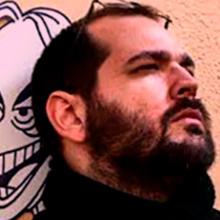Éxito es una palabra que se me queda corta
He entrevistado a varios caricaturistas españoles, a escritores y estudiosos del humor. Siempre es un placer hacerlo, ya que la calidad de sus trabajos es altísima. Sin embargo, esta vez… ¡no es la excepción!
Tenemos con nosotros a un destacadísimo caricaturista, que además es ilustrador, historietista y pintor. Pero especializado en caricatura personal: el señor Joaquín Aldeguer (Alicante, 1980).
Soy un fan total de su obra.
Y no tengo mal gusto, porque él ha publicado en muchos fanzines, diarios y revistas en varios países y también ha publicado libros. Desde 2014 hasta enero de 2023 colaboró en la famosa publicación humorística española “El Jueves”. Ha expuesto en innumerables ocasiones por el mundo.
Ha obtenido unos cuantos premios internacionales, por ejemplo, varios en Brasil, en Italia y dos veces el prestigioso World Press Cartoon (2019 y 2022) en Portugal, entre otros.
Pero mejor comenzar este “diáloco” y así los lectores se enterarán de muchas cosas de su su extensa y sólida obra…
PP: ¿Qué tal, Aldeguer? Ante todo, te agradezco infinitamente el honor de aceptar entrevistarte. Sé que trabajas mucho y tu tiempo es muy valioso. Pero, ¿estás preparado ya para responder una aldanada de preguntas? Espero que disfrutes este intercambio. A propósito, ¿te gustan que te hagan entrevistas?
ALDEGUER: Buenas tardes, Pepe. Gracias a ti por invitarme, aunque no termino de acostumbrarme a que se dirijan a mí por el apellido (no sé por qué casi todo el mundo lo hace, quizá les suene más serio y respetable, es posible, pero no lo entiendo muy bien).
Trabajo más de lo que me gustaría, pero seguramente menos de lo que merezco. Pero de vez en cuando me veo en la obligación de conceder algunos minutos a los medios, creo que este tipo de detalles me hacen más humano.
Siempre estoy preparado y dispuesto. Las entrevistas son oportunidades que aparecen en tu camino para poder abrir tu alma y compartir lo más íntimo de tu ser. Algo así como un armadillo (?)
Te agradezco también que hayas usado la palabra aldanada (que no conocía), así que he ido a buscarla al diccionario y eso que me llevo (no la he encontrado).
PP: Bueno, te explico: en la mayoría de tus obras veo que tu firma es casi un símbolo, un logo, pero he visto en otras que se lee “Aldeguer”, por eso la duda de si llamarte por tu símbolo, tu nombre o tu apellido. Es común entre los humoristas gráficos que se les trate o por su nombre artístico o por su apellido. Ejemplos: Ángel Boligán, es Boligán; Xavier Bonil, es Bonil; Omar A. Figueroa Turcios es Turcios; Honoré Daumier, es Daumier; etc., etc., por eso no me extrañó que contigo sucediera lo mismo. A partir de ahora me dirijo a ti como Joaquín. Y en cuanto al término “aldanada”, lamento que no la hayas encontrado, pero si buscas en Google, la encontrarás como sinónimo de “conisteria”. Pero dejando de lado esos detalles, te pido: ¿podrías presentarte distinto y no con tantos datos tuyos, como te presenté al inicio? Es que quizás exista alguien que no te conozca por este lado del mundo.
JOAQUÍN: Voy a intentarlo: Hola, tan sólo soy un humilde ser humano que dibuja seres humanos (pero a veces también animales, vegetales y objetos), también soy uno de los mayores cretinos que conozco y de las peores personas respondiendo a preguntas en una entrevista.
PP: Busqué “cretino” en el diccionario y encontré que es sinónimo de necio y no eres ni necio ni indonecio (no me digas ahora que no conoces esta última palabra (creo que no hace falta explicar el chistecito tampoco), porque tus obras no reflejan ese cretinismo que te autodesignas. Y sobre responder mal entrevistas, ya iremos viendo. Y paso de lleno al cuestionario que te realicé especialmente: ¿cuándo y cómo llegaste al mundo de la caricatura?
JOAQUÍN: Lo poco que recuerdo es que era menor de edad (unos 7 u 8 años) y a mi casa llegaban antiguos diarios (de semanas o meses atrás) casi de forma mágica. Eran diarios nacionales, que en mi casa entonces estaban prohibidísimos (el diario local rara vez incluye ese tipo de ilustraciones pecaminosas), así que debía ocultarlos y disfrutar de sus caricaturas en soledad. Las que más me marcaron fueron las de Pérez d’Elias en ABC (mediados/finales de los 80). Las recortaba y guardaba (no sé qué fue de aquellos recortes, una lástima). Poco después empecé a dibujar a mis profesores del colegio, compañeros de clase y algunos personajes famosos. Las caricaturas eran algo que me llamaba mucho la atención y que vi que me resultaba fácil hacerlo. También ayuda la buena aceptación de mis compañeros y familiares (no tanto así de las víctimas) para que quisiera seguir con ello, investigar y mejorar.
PP: Entiendo. Te has especializado en la caricatura personal, por eso te pregunto: para ti, ¿la caricatura no es humor gráfico? ¿Puedes profundizar un poco tu respuesta? Es que me encanta teorizar.
JOAQUÍN: Siempre he considerado que la caricatura se encuentra dentro del humor gráfico, a pesar de que haya humoristas gráficos que no la consideren así o que incluso crean que la caricatura es una categoría menor (un saludo a esos concursos que hacen tal distinción ;) ). De hecho, históricamente, la caricatura ha estado estrechamente ligada al humor gráfico. Por mis preferencias personales, me siento más cómodo con la caricatura fisonómica pura, en gran parte por lo que contestaré dentro de cuatro preguntas.
PP: Es algo increíble que consideren la caricatura personal como arte menor. Y entiendo el punto de vista de los que piensan que no es humor gráfico; sin embargo, mi opinión es que la caricatura es la expresión extrema de la parodia, una forma esta del humor. Lo que me imagino que confunda es que a veces la “víctima”; es decir, el modelo a caricaturizar, ríe o sonríe también, porque no la encuentra burlona con intención de criticar o dañar imagen. Es entonces una caricatura casi de homenaje y eso hace pensar que no es humor. Pero yo la califico como humor, porque siempre tiene la intención de sacar una risa o sonrisa, aunque haga pensar también. Pero hablando de víctima, y antes de ir a cuatro preguntas más, ¿cómo seleccionas a tu nuevo modelo para caricaturizarlo? ¿Cómo es el proceso para captar su alma y su físico y llevarlo a un plano con la técnica que sea? (La de Tina Turner es una de mis favoritas).
JOAQUÍN: Primero intento averiguar si está vivo o muerto. En caso de que aún viva, intento averiguar todo lo que puedo sobre esa persona: su lugar de residencia, sus costumbres, amistades, familia y en un momento inesperado, perseguirlo y acorralarle. En ese momento no tiene más remedio que posar (cuando consigo que se aparte las manos de la cara), así que como para entonces ya tengo al personaje estudiado, intento extraer (sin dolor) sus rasgos principales y potenciarlos al máximo sin que pierda el parecido (esto puede ser un proceso largo –o no- en el que he podido necesitar muchos bocetos antes de encontrar el “diseño” que creo que mejor funciona, luego es cuestión de pulir los detalles cuando lo termino). Con los personajes icónicos a veces puede resultar más sencillo sintetizar porque es un personaje que todos conocemos, pero también puede ser más complejo ya que lo hemos visto representado tantas veces que a veces es muy difícil no dejarse influenciar y ofrecer una visión algo distinta o innovadora, ya que, siempre que puedo, intento no recorrer el camino más obvio.
Me alegro que mi caricatura de Tina Turner sea de tus favoritas, creo que inconscientemente me inspiré en los Electroduendes (los más jóvenes y los más ancianos del lugar seguramente no sabrán de qué estoy hablando, en estos casos recomiendo una poderosísima herramienta que les hará la vida más llevadera: www.google.com).
PP: Me quedé pensando cuando dijiste que lo primero que intentas es averiguar si el personaje está vivo o muerto, y que si está vivo lo acorralas. Me imaginé acorrararlo si está muerto y que se quite las manos de la cara. Entonces sería más difícil aún ser caricaturuista personal. Pero en serio, te envidio esa habilidad de verlo y enseguida en la mente imaginarte a la persona deformada, o con rasgos exagerados, o que se parezca con un mínimo de trazos. Por ejemplo, la del Rey Juan Carlos me fascina. Y también te digo que no conocía a los “Electroduendes” (pido disculpas, pero soy un gran ignorante de esos temas). Pero lo busqué en Google y ahí comprobé lo que dices. Una duda: ¿cuál es la razón -o las razones-, para decidir si una caricatura es en blanco y negro o a color?
JOAQUÍN: ¡Muy fácil (tenía ganas de empezar una respuesta así)!
Siempre tengo en cuenta si el público al que irán dirigidas las caricaturas son daltónicas o no. Dentro de mis limitaciones, siempre intento ayudar al prójimo y facilitarles las cosas.
PP: Muy astuto y comprensivo de tu parte. ¿Entonces si van muchachas a una muestra tuya, buscando sus príncipes azules, dibujas en esa tonalidad? Cambio de tema. ¿Te ha sorprendido el éxito de tu carrera o lo planificaste desde el inicio, te lo pusiste como meta? ¿Cómo manejas el ego ante tantos premios y reconocimientos?
JOAQUÍN: Éxito es una palabra que se me queda corta, de hecho, recientemente compré un terreno para construir mi futuro museo/fundación e instalar allí vitrinas con todos mis premios, homenajes, medallas, trofeos y galardones que me han hecho a lo largo de mi dilatada carrera. También se proyectarán documentales sobre mi vida y mi trayectoria y entre otras sorpresas, tendrá una zona interactiva para los peques que va a ser la bomba.
Este éxito es fruto de varios factores, no descarto haber tenido cierta suerte, pero obviamente detrás hay un plan estratégico calculado al milímetro para conseguir mis ambiciosos objetivos. Obviamente no puedo revelar más información o tendría que eliminarte junto a los/las/les queridos/as/es lectores(os/as, etc.) de humorsapiens.com
Obviamente, estoy eternamente agradecido a todas las organizaciones, miembros de los jurados, embajadas, instituciones, medios y personalidades que me han concedido algún reconocimiento.
PP: Ja, ja. Veo que te diste el trabajo de responder extensa, pero irónicamente. Lo aclaro por si algún lector con baja comprensión lectora se lleva una imagen falsa de ti. Quizás te incomoda la pregunta. Pero conozco colegas que se sorprenden de sus logros, porque jamás pensaron que llegarían a ese nivel. Y conozco a otros que se sorprenden menos, no porque lo planearon milimétricamente, sino porque siempre fueron ambiciosos y se propusieron llegar lejos en su carrera. Aunque la pregunta estaba más enfocada al difícil manejo del ego ante los premios y el reconocimiento, sobre todo los internacionales. Pero está bien que no quieras responder en tu caso. Se entiende que puede ser un tema vergonzoso... Joaquín, has trabajado a dúo con David García Vivancos. ¿Por qué decidiste hacerlo si te iba bien en lo individual? ¿Cómo trabajan dos creadores para lograr una única obra? ¿Qué hacía -o hace-, porque no sé si continúan juntos-, cada uno? (Después de tu respuesta te contaré mi experiencia en la coautoría).
JOAQUÍN: Decidimos colaborar juntos (casi exclusivamente cuando publicábamos en El Jueves) porque somos compañeros y amigos, tenemos un sentido del humor similar y somos de distinto signo del zodiaco. La razón por la que decidí hacerlo en parte es porque no me ha ido nunca muy bien en lo individual. También porque él sabe leer y escribir y no le cuesta tener ideas para chistes sobre actualidad (y además es escorpio). Yo soy más puramente ilustrador/caricaturista y también es cierto que el humor político y de actualidad no es lo mío (ni como autor ni como lector). Generalmente él me enviaba el titular (ya que lo que más hicimos fueron portadillas) y la idea del chiste. Hablábamos sobre ello y yo lo adaptaba a mi estilo (siempre intento economizar ideas y trazos de forma que sea lo más sencilla y efectiva posible). Lamentablemente, cuando El Jueves decidió pasar a la edición mensual, prescindió de muchos colaboradores habituales, entre ellos, DGV y el otro (que soy yo). Aun así, estamos agradecidos de que nos hicieran algún hueco en la revista en portadillas, páginas y posters… y que estamos abiertos a cualquier colaboración en papel o digital (no sé si hay más formatos).
PP: De nuevo me imagino tu coraza bromística y “modéstica”, porque sin dudas, con tus caricaturas personales has sido muy exitoso en lo individual. Te dije que te diría algo sobre mi experiencia de trabajar a dúo. Lo he hecho con mi hijo Alex, que es el dibujante. Tenía la idea de un chiste gráfico y la trabajábamos ambos, entonces él se metía en el chiste y yo en sugerencias de mejor composición, color y eso. Pero él tenía la última palabra. Cuando no pudo seguir creando conmigo por su trabajo en la ilustración, me enseñó a manejar profesionalmente el Photoshop y me dediqué entonces al fotomontaje humorístico. Pero te entendí perfectamente el mecanismo de trabajo que contabas. En literatura es distinto. He publicado unos cuantos libros con humoristas literarios y la obra no es tan “fundida” como la gráfica. Bueno, espero que siga existiendo tu dúo. Y ahora me paso un poco a la teoría: ¿qué es para ti el humor?
JOAQUÍN: Uf. No tengo ni idea. Voy a buscar información sobre ello y enseguida te cuento. Media hora después: Aquí dice que es “Líquido del cuerpo de un animal o de una planta”. No estoy muy de acuerdo, especialmente en lo del animal.
PP: Siempre he puesto en duda esa definición. Sí, existen varios líquidos en el cuerpo del ser humano (ya sea éste un animal o un vegetal), pero solo aparece el humor como un plus (léase pus), cuando se infesta, ¿no es cierto? Bueno, ¿puedes contar una anécdota graciosa, ingeniosa o curiosa, que hayas vivido en tu carrera en la caricatura?
JOAQUÍN: Una vez, hice llorar a un niño pequeño en Jeju (Corea del sur), pero fue casi sin querer. También vi a Ana Morgade en una galería de arte contemporáneo, pero eso ocurrió otro día y en otro país.
PP: Creo que no es mi día como entrevistador… ¿cómo ves el humor gráfico y en especial la caricatura (sea personal, editorial o general) en la actualidad y cómo la ves en el futuro?
JOAQUÍN: Mal, regular, normal, bien, excelente, increíble, insuperable, fatal.
PP: Mala respuesta, regular respuesta, normal respuesta, buena respuesta, excelente respuesta, increíble respuesta, insuperable respuesta, fatal respuesta… ¿Te gustaría hacer algo dentro del humor que no hayas hecho hasta ahora?
JOAQUÍN: Mi ambición no conoce límites y creo que voy a expandir mi negociado a otras áreas del humor como peluquero/esteticien de simios grandes y pequeños (pero no de tamaño medio), tocar la flauta amarga a nivel semiexperto, redactor del teletexto, poder pronosticar quién va a ser el próximo Bin Laden y la cría de gatos bonsái.
PP: Ya veo. Así que para ir cerrando, ¿hubieras deseado que te hubiese hecho una pregunta y no te la hice? Y si es así, ¿puedes responderla ahora?
JOAQUÍN: Una pregunta que siempre me gusta que me hagan es la de cómo me veo dentro de 5 años y cómo me vi hace tres meses, aunque me veo incapaz de responderla. Me ha sobrado la de ¿Qué tal? Porque nunca sé qué responder (de hecho, no he respondido a esa micropregunta).
PP: Muy bien. Me queda claro. Por último, ¿podrías decirles unas palabras a nuestros seguidores de humorsapiens.com?
JOAQUÍN: Unas palabras.
PP: Perfecto. Nuestros lectores te lo agradecerán. Siento que la pasaste extraordinariamente bien con mis preguntas y eso me place. Te deseo muchos éxitos.
JOAQUÍN: Gracias de nuevo, Pepe, has sido un estupendo y bellísimo entrevistador, como pocos se han visto antes, este momento se me ha hecho tan corto que ojalá podamos volver a coincidir en otra ocasión, etcétera.
PP: Mil gracias, por lo de bellísimo, Joaquín. Es un placer entrevistar a colegas con un sentido del humor tan estimulado.
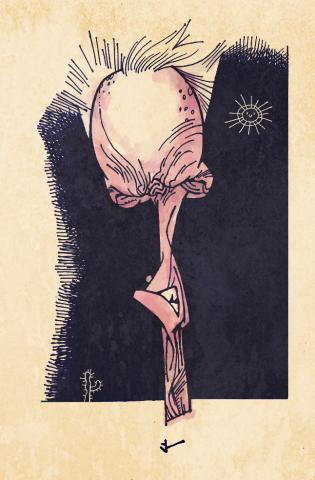
Clint Eastwood
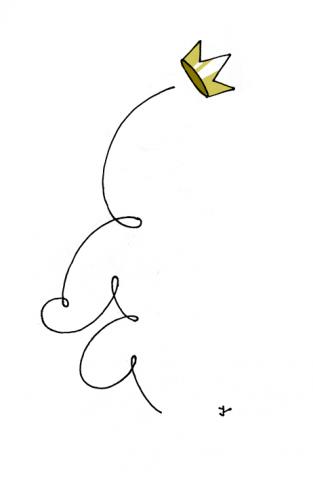
Juan Carlos abdica
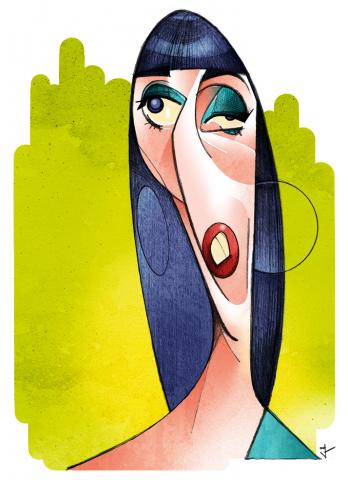
Rossy
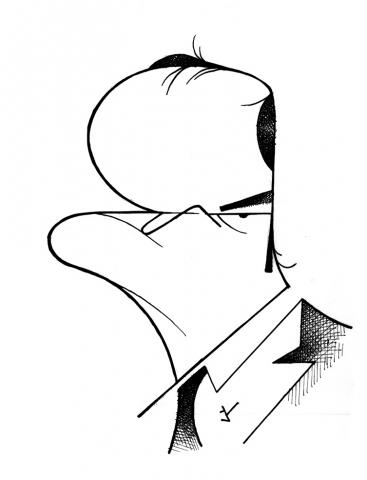
Tarantino
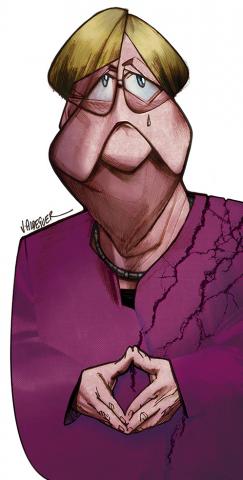
Angela Merkel
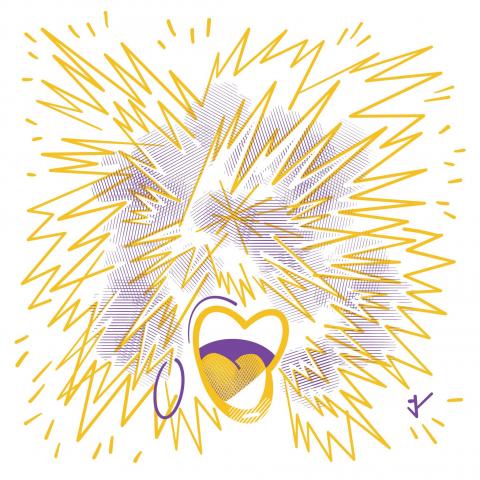
Tina Turner
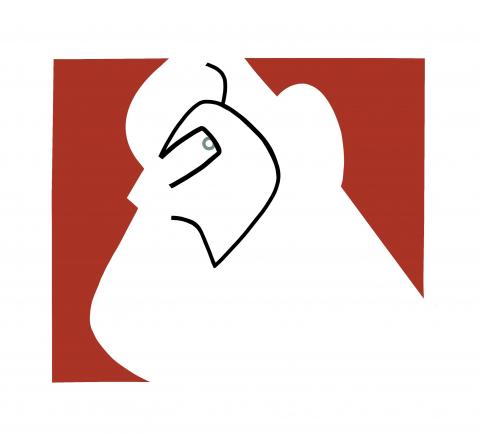
Autocaricatura
Interview with Joaquín Aldeguer
By Pepe Pelayo
Success is a word that falls short for me
I have interviewed several Spanish caricaturists, writers and humor scholars. It is always a pleasure to do it, since the quality of their work is very high. However, this time… it is no exception!
We have with us a very outstanding caricaturist, who is also an illustrator, cartoonist and painter. But specialized in personal caricature: Mr. Joaquín Aldeguer (Alicante, 1980).
I am a total fan of his work.
And I don't have bad taste, because he has published in many fanzines, newspapers and magazines in several countries and has also published books. From 2014 to January 2023 he collaborated in the famous Spanish humor publication “El Jueves”. He has exhibited countless times around the world.
He has won a few international awards, for example, several in Brazil, Italy and the prestigious World Press Cartoon twice (2019 and 2022) in Portugal, among others.
But it is better to begin this “dialogue” and thus readers will learn many things about his extensive and solid work…
PP: How are you, Aldeguer? First of all, I thank you infinitely for the honor of agreeing to interview you. I know you work hard and your time is very valuable. But are you ready to answer a barrage of questions? I hope you enjoy this exchange. By the way, do you like being interviewed?
ALDEGUER: Good afternoon, Pepe. Thank you for inviting me, although I'm still not getting used to being addressed by my last name (I don't know why almost everyone does it, maybe it sounds more serious and respectable to them, it's possible, but I don't understand it very well) .
I work more than I would like, but surely less than I deserve. But from time to time I am forced to give a few minutes to the media, I think these types of details make me more human.
I am always prepared and willing. Interviews are opportunities that appear on your path to open your soul and share the most intimate part of your being. Something like an armadillo (?)
I also thank you for using the word aldanada (which I didn't know), so I went to look for it in the dictionary and that's what I took with me (I haven't found it).
PP: Well, I'll explain to you: in most of your works I see that your signature is almost a symbol, a logo, but I have seen in others that it reads “Aldeguer”, which is why I doubt whether to call you by your symbol, your name. or your last name. It is common among graphic comedians to be addressed either by their stage name or by their last name. Examples: Ángel Boligan, is Boligan; Xavier Bonil, is Bonil; Omar A. Figueroa Turcios is Turcios; Honoré Daumier, is Daumier; etc., etc., that's why I wasn't surprised that the same thing happened with you. From now on I address you as Joaquín. And as for the term “aldanada”, I'm sorry you didn't find it, but if you Google it, you'll find it as a synonym for “conisteria”. But leaving aside those details, I ask you: could you introduce yourself differently and not with so much information about yourself, as I presented to you at the beginning? Maybe there is someone who doesn't know you on this side of the world.
JOAQUÍN: I'm going to try: Hello, I'm just a humble human being who draws human beings (but sometimes also animals, plants and objects), I'm also one of the biggest jerks I know and one of the worst people at answering questions in a interview.
PP: I looked up “cretin” in the dictionary and found that it is synonymous with fool and you are neither stupid nor stupid (don't tell me now that you don't know this last word (I don't think it's necessary to explain the little joke either), because your works don't They reflect that cretinism that you designate yourself. And about answering interviews poorly, we'll see. And I move on directly to the questionnaire that I specially asked you: when and how did you come to the world of cartoons?
JOAQUÍN: The little I remember is that I was a minor (about 7 or 8 years old) and old diaries (from weeks or months ago) arrived at my house almost in a magical way. They were national newspapers, which were extremely prohibited in my house at that time (the local newspaper rarely includes these types of sinful illustrations), so I had to hide them and enjoy their cartoons in solitude. The ones that stood out to me the most were those of Pérez d'Elias on ABC (mid/late 80s). I cut them out and saved them (I don't know what happened to those cuts, a shame). Shortly after I started drawing my school teachers, classmates and some famous people. Caricatures were something that caught my attention and I saw that it was easy for me to do it. The good acceptance of my colleagues and family (not so much of the victims) also helps so that I would like to continue with it, investigate and improve.
PP: I understand. You have specialized in personal caricature, that's why I ask you: for you, isn't caricature graphic humor? Can you elaborate a little on your answer? It's just that I love to theorize.
JOAQUÍN: I have always considered that caricature is within graphic humor, despite the fact that there are graphic humorists who do not consider it that way or who even believe that caricature is a minor category (shout out to those contests that make such a distinction ;) ). In fact, historically, caricature has been closely linked to graphic humor. Due to my personal preferences, I feel more comfortable with pure physiognomic caricature, largely because of what I will answer in four questions.
PP: It is something incredible that they consider personal caricature as a minor art. And I understand the point of view of those who think that it is not graphic humor; However, my opinion is that caricature is the extreme expression of parody, a form of humor. What I imagine is confusing is that sometimes the “victim”; That is, the model to be caricatured laughs or smiles too, because he does not find it mocking with the intention of criticizing or damaging the image. It is then a caricature almost of homage and that suggests that it is not humor. But I classify it as humor, because it is always intended to make you laugh or smile, even though it also makes you think. But speaking of victim, and before going to four more questions, how do you select your new model to caricature? What is the process like to capture your soul and your physique and bring it to a plane with whatever technique? (Tina Turner's is one of my favorites).
JOAQUÍN: First I try to find out if he is alive or dead. If he is still alive, I try to find out everything I can about that person: his place of residence, his customs, friends, family and at an unexpected moment, chase him and corner him. At that moment he has no choice but to pose (when I get him to move his hands away from his face), so since by then I have already studied the character, I try to extract (without pain) his main features and enhance them to the maximum without losing the similar (this may or may not be a long process in which I may have needed many sketches before finding the “design” that I think works best, then it is a matter of polishing the details when I finish it). With iconic characters it can sometimes be easier to synthesize because it is a character that we all know, but it can also be more complex since we have seen it represented so many times that sometimes it is very difficult not to be influenced and offer a somewhat different or innovative vision. , since, whenever I can, I try not to take the most obvious path.
I'm glad that my caricature of Tina Turner is one of your favorites, I think I was unconsciously inspired by the Electrogoblins (the youngest and oldest people in the place will surely not know what I'm talking about, in these cases I recommend a very powerful tool that will help them more bearable life: www.google.com).
PP: I was thinking when you said that the first thing you try to do is figure out if the character is alive or dead, and if he's alive you corner him. I figured I'd corner him if he's dead and make him take his hands off his face. Then it would be even more difficult to be a personal cartoonist. But seriously, I envy you that ability to see it and immediately imagine the person in your mind deformed, or with exaggerated features, or that resembles it with a minimum of strokes. For example, that of King Juan Carlos fascinates me. And I also tell you that I did not know about the “Electroduendes” (I apologize, but I am very ignorant of these topics). But I looked it up on Google and there I verified what you say. A question: what is the reason - or reasons - to decide whether a cartoon is in black and white or color?
JOAQUÍN: Very easy (I wanted to start a response like that)!
I always take into account whether the audience to which the cartoons will be directed is colorblind or not. Within my limitations, I always try to help others and make things easier for them.
PP: Very astute and understanding of you. So if girls come to your exhibition, looking for their prince charming, do you draw in that tone? Topic change. Have you been surprised by the success of your career or did you plan it from the beginning, did you set it as a goal? How do you manage your ego in the face of so many awards and recognitions?
JOAQUÍN: Success is a word that falls short for me, in fact, I recently bought land to build my future museum/foundation and install display cases there with all my awards, tributes, medals, trophies and awards that have been given to me throughout the years. my long career. Documentaries about my life and my career will also be shown and among other surprises, there will be an interactive area for the little ones that is going to be the bomb.
This success is the result of several factors, I do not rule out having had some luck, but obviously behind it there is a strategic plan calculated to the millimeter to achieve my ambitious objectives. Obviously I cannot reveal more information or I would have to eliminate you along with the dear readers, etc. of humorsapiens.com
Obviously, I am eternally grateful to all the organizations, members of the juries, embassies, institutions, media and personalities that have granted me some recognition.
PP: Ha ha. I see that you took the time to respond at length, but ironically. I clarify this in case any reader with low reading comprehension gets a false image of you. Maybe the question bothers you. But I know colleagues who are surprised by their achievements, because they never thought they would reach that level. And I know others who are less surprised, not because they planned it to the millimeter, but because they were always ambitious and set out to go far in their career. Although the question was more focused on the difficult management of ego in the face of awards and recognition, especially international ones. But it's okay that you don't want to answer in your case. It is understood that it can be an embarrassing topic... Joaquín, you have worked as a duet with David García Vivancos. Why did you decide to do it if it was going well for you individually? How do two creators work to achieve a single work? What did - or does - because I don't know if they are still together - each one? (After your answer I will tell you about my experience in co-authorship).
JOAQUÍN: We decided to collaborate together (almost exclusively when we published in El Jueves) because we are colleagues and friends, we have a similar sense of humor and we are of different zodiac signs. The reason I decided to do it in part is because I have never done very well individually. Also because he knows how to read and write and it is not difficult for him to come up with ideas for jokes about current events (and he is also a Scorpio). I am more purely an illustrator/caricaturist and it is also true that political and current humor is not my thing (neither as an author nor as a reader). Generally he sent me the headline (since what we did most were covers) and the idea of the joke. We talked about it and I adapted it to my style (I always try to economize ideas and strokes in a way that is as simple and effective as possible). Unfortunately, when El Jueves decided to move to the monthly edition, it dispensed with many regular collaborators, including DGV and the other one (which is me). Even so, we are grateful that they made some space for us in the magazine on covers, pages and posters... and that we are open to any collaboration in paper or digital (I don't know if there are more formats).
PP: Once again I imagine your joking and “modest” armor, because without a doubt, with your personal caricatures you have been very successful individually. I told you I would tell you something about my experience working as a duo. I have done it with my son Alex, who is the artist. He had the idea of a graphic joke and we both worked on it, so he got into the joke and I got into suggestions for better composition, color and so on. But he had the last word. When he couldn't continue creating with me because of his work in illustration, he taught me how to use Photoshop professionally and I then dedicated myself to humorous photomontage. But I understood perfectly the working mechanism that you mentioned. In literature it is different. I have published a few books with literary humorists and the work is not as “fused” as the graphic one. Well, I hope your duo continues to exist. And now I move on to theory a little: what does humor mean to you?
JOAQUIN: Ugh. I have no idea. I'm going to look for information about it and I'll tell you right away. Half an hour later: Here it says that it is “Liquid from the body of an animal or a plant.” I don't really agree, especially about the animal.
PP: I have always questioned that definition. Yes, there are various liquids in the human body (whether it is an animal or a plant), but humor only appears as a plus (read pus), when it is infested, right? Well, can you tell a funny, witty or curious anecdote that you have experienced in your career in cartooning?
JOAQUIN: I once made a little boy cry in Jeju (South Korea), but it was almost accidentally. I also saw Ana Morgade in a contemporary art gallery, but that happened on another day and in another country.
PP: I think it's not my day as an interviewer... how do you see graphic humor and especially caricature (whether personal, editorial or general) currently and how do you see it in the future?
JOAQUÍN: Bad, average, normal, good, excellent, incredible, insurmountable, fatal.
PP: Bad response, average response, normal response, good response, excellent response, incredible response, unbeatable response, fatal response... Would you like to do something within humor that you haven't done until now?
JOAQUÍN: My ambition knows no limits and I think I am going to expand my business to other areas of humor as a hairdresser/beautician of large and small apes (but not medium-sized), play the bitter flute at a semi-expert level, teletext editor, power predict who is going to be the next Bin Laden and breeding bonsai cats.
PP: I see. So in closing, do you wish I had asked you a question and didn't? And if so, can you answer it now?
JOAQUÍN: A question that I always like to be asked is how I see myself in 5 years and how I saw myself three months ago, although I find myself unable to answer it. I have left over the one from How are you? Because I never know what to answer (in fact, I haven't answered that micro question).
PP: Very good. It's clear to me. Finally, could you say a few words to our humorsapiens.com followers?
JOAQUÍN: A few words.
PP: Perfect. Our readers will thank you. I feel like you had an extraordinarily good time with my questions and I'm pleased with that. I wish you a lot of success.
JOAQUÍN: Thank you again, Pepe, you have been a wonderful and beautiful interviewer, like few have seen before, this moment has seemed so short that I hope we can meet again on another occasion, etc.
PP: Thank you so much for being so beautiful, Joaquín. It is a pleasure to interview colleagues with such a stimulating sense of humor.
(This text has been translated into English by Google Translate)

